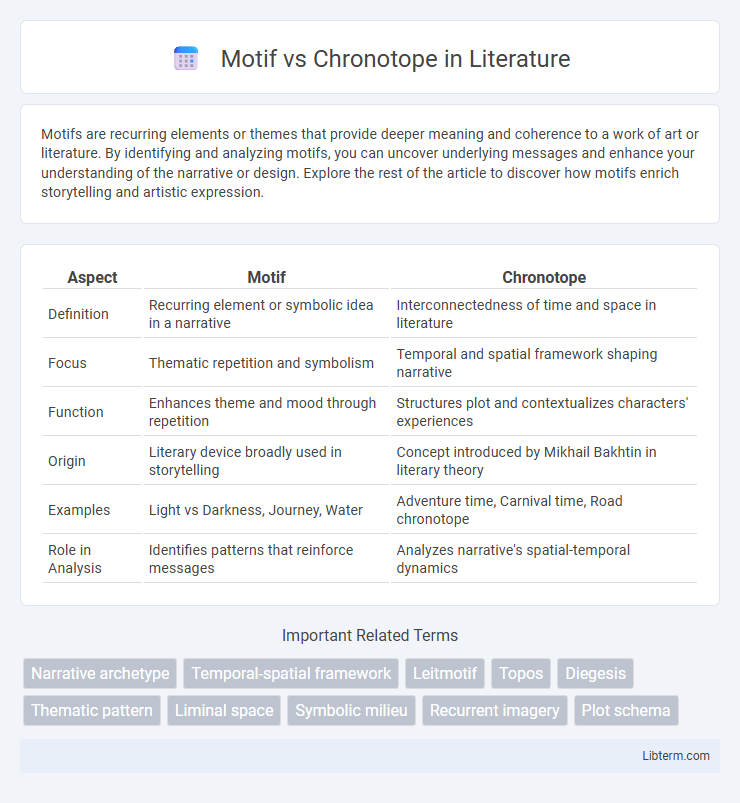Motifs are recurring elements or themes that provide deeper meaning and coherence to a work of art or literature. By identifying and analyzing motifs, you can uncover underlying messages and enhance your understanding of the narrative or design. Explore the rest of the article to discover how motifs enrich storytelling and artistic expression.
Table of Comparison
| Aspect | Motif | Chronotope |
|---|---|---|
| Definition | Recurring element or symbolic idea in a narrative | Interconnectedness of time and space in literature |
| Focus | Thematic repetition and symbolism | Temporal and spatial framework shaping narrative |
| Function | Enhances theme and mood through repetition | Structures plot and contextualizes characters' experiences |
| Origin | Literary device broadly used in storytelling | Concept introduced by Mikhail Bakhtin in literary theory |
| Examples | Light vs Darkness, Journey, Water | Adventure time, Carnival time, Road chronotope |
| Role in Analysis | Identifies patterns that reinforce messages | Analyzes narrative's spatial-temporal dynamics |
Introduction to Motif and Chronotope
A motif is a recurring element, symbol, or concept that reinforces the theme and adds depth to a literary work. The chronotope, coined by Mikhail Bakhtin, refers to the intrinsic connectedness of time and space in a narrative, shaping the story's structure and meaning. Understanding motifs and chronotopes allows deeper analysis of how themes and contexts interact within literature.
Defining Motif in Literary Studies
A motif in literary studies is a recurring element, such as an image, symbol, theme, or idea, that reinforces the central message or underlying themes of a narrative. Unlike the chronotope, which refers to the intrinsic connectedness of temporal and spatial relationships in literature as defined by Mikhail Bakhtin, a motif functions at the symbolic level to create patterns that evoke deeper meanings. Motifs contribute to the coherence of a text by highlighting significant concepts and enhancing readers' interpretive engagement.
Understanding Chronotope: Time and Space in Literature
Chronotope refers to the intrinsic connectedness of temporal and spatial relationships in literature, shaping how narratives unfold within defined timeframes and settings. It establishes the context where characters interact and events transpire, revealing cultural and social dimensions through specific times and places. Understanding chronotope enhances literary analysis by highlighting the dynamic interplay between time and space, distinguishing it from motifs, which are recurring thematic elements without fixed spatiotemporal parameters.
Motif vs Chronotope: Key Differences
Motif refers to a recurring element, symbol, or idea within a literary work that reinforces the theme or mood, while chronotope represents the intrinsic connectedness of temporal and spatial relationships in literature, defining the framework of time and place. Motiv is thematic and symbolic, often highlighting specific emotional or conceptual layers, whereas chronotope structures the narrative's context and influences character actions through the interplay of time and space. Understanding the key differences between motif and chronotope enhances literary analysis by distinguishing symbolic repetition from narrative environment.
Historical Origins and Theoretical Foundations
Motif and chronotope originate from distinct theoretical frameworks in literary studies, with motifs tracing back to folkloristics and structuralism, specifically the work of Vladimir Propp who identified recurring narrative elements. The chronotope, a concept introduced by Mikhail Bakhtin, situates time and space as interconnected dimensions that shape narrative meaning and genre. While motifs function as repeatable thematic units within texts, chronotopes provide a dynamic spatial-temporal context that influences character interaction and plot development.
Functions of Motif in Narrative Structure
Motifs serve as recurring elements that reinforce themes and create coherence within a narrative, guiding readers' interpretation and emotional response. They function to highlight character development, symbolize abstract ideas, and establish mood by recurring in varied contexts throughout the story. Unlike chronotopes, which integrate time and space in narrative settings, motifs primarily enhance thematic depth and narrative unity.
The Role of Chronotope in Shaping Narrative Context
Chronotope, a concept introduced by Mikhail Bakhtin, defines the intrinsic connectedness of temporal and spatial relationships in narrative, shaping the story's context by situating events within specific time-space frameworks that influence characters and plot development. Unlike motifs, which are recurring symbolic elements or themes that reinforce a narrative's message, chronotopes construct the narrative's world, grounding its reality and guiding the reader's interpretation. The role of chronotope is crucial in literature as it frames how the storyline unfolds, providing a structure for understanding the interactions between characters and their environments within a dynamic temporal progression.
Examples: Motif and Chronotope in Classic Literature
Motifs such as the "green light" in F. Scott Fitzgerald's *The Great Gatsby* symbolize hope and the American Dream, while chronotopes like the "road" in Jack Kerouac's *On the Road* frame the narrative through a specific time-space continuum emphasizing freedom and movement. The motif of "blood" in Shakespeare's *Macbeth* represents guilt and violence, whereas the chronotope of the "castle" in Gothic literature creates an enclosed, timeless setting that heightens suspense and psychological tension. Motifs often recur as symbolic images or concepts across a text, while chronotopes integrate temporal and spatial dimensions to shape the story's structure and meaning.
Analyzing the Interplay: How Motif and Chronotope Intersect
Motif and chronotope intersect by embedding recurring symbols within specific temporal and spatial contexts, enriching narrative meaning and thematic depth. While motifs provide symbolic repetition, chronotopes frame these symbols through defined time-space constructs, enabling a dynamic interaction that shapes readers' interpretation of plot and character development. This interplay enhances the narrative's complexity by anchoring abstract motifs in concrete experiential realities.
Conclusion: Significance in Literary Analysis
Motifs and chronotopes serve distinct but complementary roles in literary analysis, with motifs emphasizing recurring thematic elements and chronotopes highlighting the intrinsic link between time and space within narratives. Recognizing motifs enhances the understanding of a text's underlying messages and symbolic patterns, while analyzing chronotopes provides insight into how temporal and spatial contexts shape character development and plot dynamics. Together, these concepts deepen the interpretive framework, allowing for a more nuanced exploration of literary works' meaning and structure.
Motif Infographic

 libterm.com
libterm.com